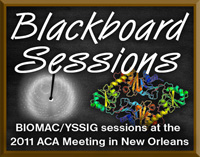Overview
This website accompanies session 08.19, "Phasing And Refinement For Dummies: No Book Required" co-chaired by Edward Collins and Andrew Torelli at the 2011 ACA Meeting in New Orleans. In this session, the authors of five popular X-ray crystallographic structure phasing/refinement programs, CNS, PHENIX, Refmac, BUSTER and SHELX, will demonstrate the use of their software solving/refining X-ray crystal structures exhibiting different challenges of "typical difficulty".
Goal
The target audience is novice to advanced-intermediate X-ray crystallographers. The goal is to educate users not only in how to properly handle each "dataset scenario", but also empower users with the knowledge of how to properly use additional/alternative X-ray structure phasing/refinement software packages they might not have used before.
Software and Datasets
Follow the links to the left to find the three example datasets that will be showcased during the session and free versions of the software that will be used. The datasets were each selected to be representative of common challenges for X-ray structure phasing/refinement (e.g. hemihedral twinning, a weak anomalous signal and low-resolution data). These datasets were selected to be "tough, but workable." For each dataset, the initial data (merged reflection files) are available for download as well the solved coordinate file, the associated reflection file with phases, log files and a list of instructions produced by each of the authors using their software. Finally, the output from SFCheck generated for each of the processed data files is available to provide an "apples-to-apples" comparison of the data produced using each software program.
Your Role
You are encouraged to download the starting merged reflection files for each "dataset scenario" and try phasing/refining them on your own using the different software (available from link at left). You can then compare your results/method with those of the author and be prepared to ask questions during the session at the ACA meeting. Remember, your feedback is valuable to the authors! Please let them know what could be improved. If you have trouble with this website, please e-mail Andy Torelli (att29 at cornell dot edu).
Acknowledgements
This venture would not be possible without the considerable efforts of several people and generous funding from both the ACA and our corporate sponsors. We are grateful for their help. We are specifically indebted to James Holton for providing extensive logistical support, helpful discussions, for generating several datasets exhibiting the pathologies we desired for the tutorials (produced using his MLFSOM software) and also for providing the output from his own data processing program Elves as a starting point for the examples in this session. We also thank Axel Brünger (CNS), Pavel Afonine (PHENIX), Garib Mushurdov (Refmac), Gerard Bricogne (BUSTER) and George Sheldrick (SHELX), the speaker/authors who skillfully phased and refined the example structures and also generated documents describing their methods/use of the software. Also, a special thanks to John Rose, Zbigniew Dauter, Juergen Bosch, Wladek Minor and Kay Diederichs for providing example datasets. Finally, we thank our generous sponsors, the American Crystallographic Association, Area Detector Systems (ADSC), Bruker, Dectris, Global Phasing Limited, Rayonix and Rigaku whose support of these sessions was essential to bring in the speakers and pay for lunch between the sessions. Finally, thanks to Alyssa Crick for her graphic design work.







